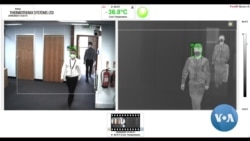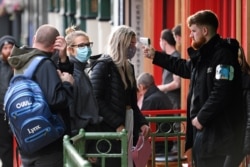Eager to open up, companies, shopping centers and sports venues worldwide are looking into thermal imaging technology that picks up the body temperature of people entering buildings in order to deter the spread of COVID-19, the disease caused by the coronavirus.
Demand for technology that automatically scans for a fever has grown globally since the pandemic began. With that demand, there are also concerns about privacy, security and other workplace issues, experts say.
Companies "need to be mindful of the fact that collecting data about people in particular is increasingly seen as a liability," said Bhaskar Krishnamachari, an electrical and computer engineering professor at the University of Southern California. "If that data, for example, gets hacked, gets abused, there can be a lot of repercussions, even financially, for the organizations involved."
Businesses that are reopening and employers who have to keep their doors open during a pandemic in industries such as transportation, food processing and government are scrambling to come up with ways to keep sick people out.
Many stores, doctors' offices and salons take people's temperatures with handheld thermometers, but those devices cannot be used for large venues with a lot of foot traffic, such as stadiums and airports.
One solution is a thermal camera or sensors placed at building entrances. When used correctly, these systems measure skin temperatures accurately, according to the U.S. Food and Drug Administration (FDA).
Before the pandemic, Thermoteknix Systems Ltd., a firm based in England, was shipping approximately 10 of its FevIR Scan Fever Screening Systems a month. When the pandemic hit, demand for the thermal imaging cameras skyrocketed, first in February in Asia and then in the rest of the world.
Now the company is shipping up to 100 devices a day worldwide. Thermoteknix develops the hardware and software for FevIR Scan, an infrared camera that measures body heat by sensing the temperature around the eyes' tear ducts to get the best correlation to core body temperature.
"If you imagine those little point-and-shoot detector guns that everyone has that's looking at a small spot on the forehead or on the temple, an infrared camera is about 110,000 of those point-and-shoot cameras. They're not shining a laser. They are waiting for the heat to hit them," said Max Salisbury, operations director at Thermoteknix Systems.
U.S.-based FLIR's infrared cameras "look for those (people) that have elevated skin temperature higher than the last 10 people that have been screened" to account for environmental changes throughout the day, said Chris Bainter, FLIR's vice president of global business development.
Limits of thermal imaging systems
There are limits to these thermal technologies, according to the FDA. People with COVID-19 could be contagious without a fever, and a fever is only one symptom of COVID-19.
Even if companies say their technology can take the temperatures of multiple people at a time, the FDA does not recommend "mass fever screening," because these types of systems "have not been shown to be accurate when used to take the temperature of multiple people at the same time."
FDA guidelines include screening one person at a time at a fixed distance. Companies would have to place multiple screening devices, such as infrared cameras, at entrances so more people can get through the door quicker.
Labor and digital concerns
While thermal scanners at the entrance of buildings can protect employees inside by keeping someone with a fever out, University of California Berkeley Labor Center researcher Jessie HF Hammerling said the technology raises workplace issues.
"If your employer is going to stop you coming in the door because you have a temperature, it would also be really good if (the) employer was offering paid sick leave," she said. "So that workers don't have an incentive to try to sneak into work when they might potentially be infected."
On the digital side, technologists warn there should be scrutiny on privacy concerns anytime data about humans or their behavior is collected.
ThermalPass, a Canadian firm, sells a machine that looks like a metal detector with a daisy chain of thermal sensors that a person walks through to enter a building. One of its selling points? The absence of cameras on the machine "preserves one's anonymity," ThermalPass President Michael Lende said.
A specific application of a technology may seem harmless when it is first deployed, Krishnamachari warned, but once the data is collected, it could be associated with other data and used in ways that are unclear.
"You have a system that's only looking at body temperature. But what if there's another system deployed in the same space that monitors Bluetooth beacons, and what if there's a third-party system which is able to correlate these Bluetooth beacons with identities of individuals that are walking into this space?" Krishnamachari asked.
Threat to privacy?
When data is not kept in separate silos, there could be a threat to privacy, he said.
Some companies that develop thermal imaging technology said they address that concern by making sure their systems are not connected to the internet. Data is stored locally in the software of the owner of the thermal imaging device. Still, other companies allow information to be stored in the cloud, in servers accessed over the internet.
For developers of thermal imaging systems as well as companies and organizations that use this type of technology, Krishnamachari said there should be rules to not only ensure that privacy is protected but also to minimize the risk for companies if there is a data breach.
"Ultimately, someone has to take responsibility to say not only is this individual data gathering system anonymous, we've taken a set of measures to make sure that the data collected by the system is isolated from any other data collection systems we have in place," Krishnamachari said.
Technologists reiterated that data collected should be transparent, secured and should, in some cases, have an expiration date for storage. Companies should only collect the minimum data needed for the specific application.
Whether temperature screening devices will be a part of the new normal is yet to be seen. Some developers of the technology said this line of defense can be a part of the new security landscape, similar to a burglar or fire alarm.
"It really is a new kind of sentry for your entrance," Daniel Putterman, chief executive officer of Kogniz Inc., a company that not only has thermal cameras that screen for fevers but also determine if people are wearing masks or observing social distance.








